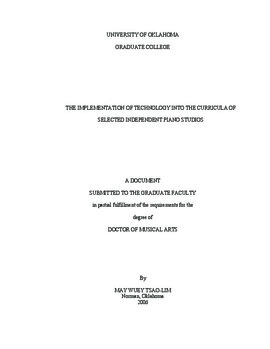| dc.contributor.advisor | Magrath, Jane, | en_US |
| dc.contributor.advisor | Fast, Barbara, | en_US |
| dc.contributor.author | Tsao-lim, May Wuey. | en_US |
| dc.date.accessioned | 2013-08-16T12:20:19Z | |
| dc.date.available | 2013-08-16T12:20:19Z | |
| dc.date.issued | 2006 | en_US |
| dc.identifier.uri | https://hdl.handle.net/11244/1069 | |
| dc.description.abstract | Of the 225 returned surveys, 76 independent piano teachers with 12 or more students reported using one or more forms of technology in their curricula: 47 used computers in their teaching, 47 used keyboard technology, 44 used accompaniment disks, and 16 used the Internet for teaching. Sixty-two percent of the 76 teachers employed two or more forms of technology in their studios. Digital keyboard technology was the primary teaching tool for 36% of the 47 keyboard users. Computer-assisted instruction software received much wider usage (91% of 47 computer users) than notation, sequencing, and accompaniment application software (51%). Although 93% of 47 teachers had Internet access, only 36% taught with the technology. Most of the 76 teachers reported the positive pedagogical impact of technology use in their curricula and listed workshops/seminars and colleagues as the foremost resources for acquiring knowledge on music technology. | en_US |
| dc.description.abstract | A 51-item questionnaire was sent to 400 independent piano teachers from the Music Teachers National Association's (MTNA) membership list to seek information on the implementation of technology into their curricula. The survey covered topics such as the purposes and methods of using different types of technology, successes and limitations in the use of technology, and factors hindering the incorporation of technology into independent piano studios. | en_US |
| dc.description.abstract | The primary purpose of this exploratory study was to examine the extent to which selected independent piano teachers with 12 or more pre-college students incorporated technology into their curricula including the use of computer and keyboard technologies, software, accompaniment disks (MIDI/CD), and the Internet. A secondary purpose was to provide information on teachers' attitudes toward the use of technologies in private piano curricula. The conclusions and recommendations presented, along with the annotated bibliography of Internet resources and a list of software program features, serve as a reference for independent piano teachers currently teaching with technology or interested in incorporating technology into their curricula. | en_US |
| dc.description.abstract | Future research could benefit from further investigation of the pedagogical use of digital reproducing pianos and accompaniment disks, as well as the achievement of students who are involved in curricula that incorporate various forms of technology. | en_US |
| dc.format.extent | xi, 219 leaves : | en_US |
| dc.subject | Piano Instruction and study. | en_US |
| dc.subject | Education, Technology of. | en_US |
| dc.subject | Piano Methods. | en_US |
| dc.subject | Education, Music. | en_US |
| dc.subject | Educational technology. | en_US |
| dc.subject | Music. | en_US |
| dc.title | The implementation of technology into the curricula of selected independent piano studios. | en_US |
| dc.type | Thesis | en_US |
| dc.thesis.degree | D.M.A. | en_US |
| dc.thesis.degreeDiscipline | School of Music | en_US |
| dc.note | Advisers: Jane Magrath; Barbara Fast. | en_US |
| dc.note | Source: Dissertation Abstracts International, Volume: 67-05, Section: A, page: 1586. | en_US |
| ou.identifier | (UMI)AAI3220372 | en_US |
| ou.group | Weitzenhoffer Family College of Fine Arts::School of Music | |
